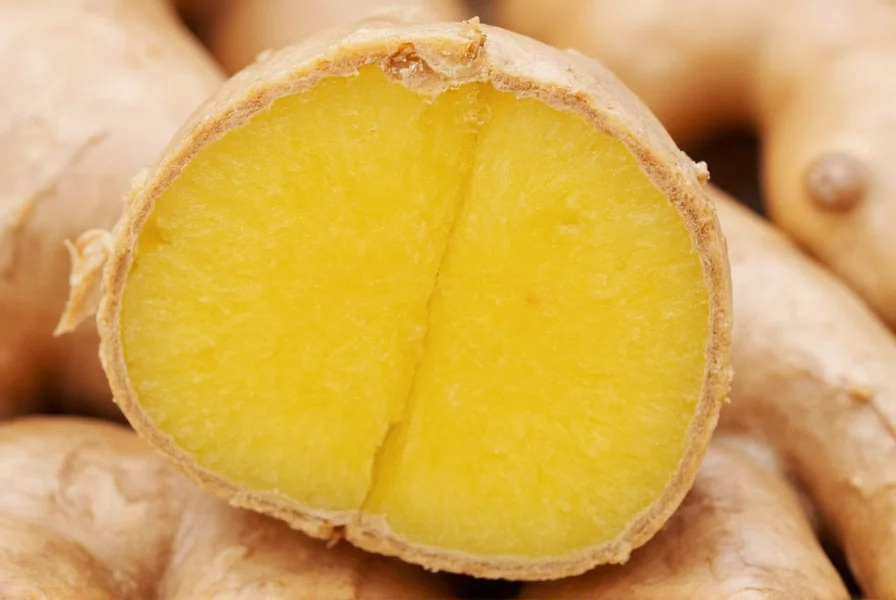
Nutritional Profile of Ginger Root
Ginger (Zingiber officinale) has been valued for both culinary and medicinal purposes for thousands of years. Modern nutritional analysis confirms its impressive nutrient density despite being consumed in relatively small quantities. Understanding the complete nutritional composition of ginger helps consumers maximize its health benefits while incorporating it into daily diets.
| Nutrient | Amount per 100g | Amount per 1 Tbsp (6g) | Daily Value % |
|---|---|---|---|
| Calories | 80 | 4 | <1% |
| Total Carbohydrates | 17.8g | 1.1g | 1% |
| Dietary Fiber | 2.0g | 0.1g | 1% |
| Sugar | 1.7g | 0.1g | - |
| Protein | 1.8g | 0.1g | 1% |
| Vitamin B6 | 0.16mg | 0.01mg | 1% |
| Magnesium | 43mg | 2.6mg | 1% |
| Potassium | 415mg | 25mg | 1% |
Key Bioactive Compounds in Ginger
The true food value of ginger extends beyond basic macronutrients and vitamins. Ginger contains over 400 distinct biochemical compounds, with gingerols representing the most pharmacologically active components. These compounds are responsible for ginger's characteristic pungency and many of its health-promoting properties.
Gingerols transform into shogaols when ginger is dried or cooked, which are even more potent antioxidants. This explains why difference between fresh and dried ginger nutrition matters for specific health applications. Research published in the Journal of Agricultural and Food Chemistry confirms that 6-gingerol constitutes approximately 3-5% of fresh ginger's weight and demonstrates significant anti-inflammatory effects at the cellular level.
Science-Backed Health Benefits
Multiple clinical studies validate ginger's role in supporting human health. A comprehensive meta-analysis in the journal Nutrients (2022) examined 109 clinical trials involving ginger supplementation. The analysis confirmed ginger's effectiveness for:
- Digestive health support - Reducing nausea and vomiting, particularly during pregnancy and chemotherapy
- Inflammation reduction - Decreasing markers of inflammation like C-reactive protein by up to 28% in osteoarthritis patients
- Blood sugar regulation - Improving insulin sensitivity in prediabetic individuals
- Antioxidant protection - Neutralizing free radicals that contribute to cellular aging
The ginger anti-inflammatory properties work through multiple mechanisms, including inhibition of cyclooxygenase and lipoxygenase pathways—similar to how some non-steroidal anti-inflammatory drugs function, but without the same side effect profile.
Practical Dietary Incorporation
Understanding how much ginger should I eat per day is crucial for maximizing benefits while avoiding potential side effects. Most clinical studies showing therapeutic effects used doses between 1-3 grams of fresh ginger daily (approximately 1-2 tablespoons). This amount provides sufficient gingerols without causing gastrointestinal discomfort in most people.
Effective ways to incorporate ginger into your daily routine include:
- Adding freshly grated ginger to smoothies (1-2 teaspoons)
- Steeping 1-2 slices of fresh ginger in hot water for tea
- Using ginger in stir-fries and sauces (1-2 tablespoons)
- Adding ground ginger to baked goods and oatmeal
- Preparing ginger shots (1 ounce of freshly juiced ginger)
For those interested in the ginger root vitamins and minerals content specifically, consuming ginger with healthy fats like coconut oil or avocado enhances absorption of its fat-soluble compounds.
Considerations and Limitations
While ginger offers numerous benefits, certain populations should exercise caution. Individuals taking blood-thinning medications should consult their healthcare provider before consuming large amounts of ginger due to potential interactions. The potential side effects of too much ginger may include heartburn, diarrhea, and mouth irritation, particularly when consuming more than 4 grams daily.
Pregnant women should limit ginger intake to no more than 1 gram daily during the first trimester, though ginger remains one of the most recommended natural remedies for morning sickness. Those with gallstone disease should also consult a physician before increasing ginger consumption, as it may stimulate bile production.
Maximizing Ginger's Nutritional Value
To preserve the maximum ginger nutrition facts per 100g when preparing ginger, consider these evidence-based tips:
- Store fresh ginger in a paper bag in the refrigerator crisper drawer for up to three weeks
- Freeze whole ginger root and grate directly from frozen to preserve compounds
- Avoid boiling ginger for extended periods, which degrades heat-sensitive compounds
- Combine ginger with black pepper to enhance bioavailability of its active compounds
- Use the entire ginger root, including the skin (when organic), which contains additional fiber
Research published in Food Chemistry demonstrates that grating fresh ginger and allowing it to sit for 5 minutes before use increases the concentration of beneficial compounds through enzymatic action.
Frequently Asked Questions
What is the most nutritious form of ginger to consume?
Fresh ginger root provides the highest concentration of gingerols, the primary bioactive compounds. While dried ginger contains higher concentrations of shogaols (transformed gingerols), fresh ginger offers a broader spectrum of volatile compounds. For maximum nutritional benefit, use fresh ginger that has been grated and allowed to sit for 5 minutes before consumption.
How does ginger compare to other common spices nutritionally?
Ginger stands out among spices for its unique combination of gingerols and high magnesium content. While turmeric contains curcumin (another potent anti-inflammatory), ginger provides more immediate digestive benefits. Compared to cinnamon, ginger has significantly higher potassium content. Unlike many spices consumed in smaller quantities, ginger's distinctive flavor allows for larger daily consumption, increasing its overall nutritional impact.
Can ginger help with weight management?
Research suggests ginger may support weight management through several mechanisms. A 2021 meta-analysis in Obesity Reviews found ginger supplementation associated with modest reductions in body weight, waist-to-hip ratio, and insulin resistance. Ginger appears to enhance thermogenesis and fat metabolism while promoting satiety. However, it should be viewed as a complementary approach rather than a standalone solution for weight management.
Does cooking affect ginger's nutritional value?
Cooking transforms but doesn't eliminate ginger's nutritional benefits. Heat converts gingerols to shogaols, which are more stable and potentially more potent antioxidants. While some volatile compounds diminish with prolonged high-heat cooking, the overall antioxidant capacity remains significant. For maximum benefit, add ginger toward the end of cooking rather than at the beginning, and avoid boiling for extended periods.
How quickly can I expect to notice health benefits from regular ginger consumption?
The timeline for experiencing benefits varies by application. For digestive issues like nausea, effects may be noticeable within 30-60 minutes. For inflammation reduction in conditions like osteoarthritis, consistent daily consumption for 4-6 weeks typically shows measurable improvement. Blood sugar regulation benefits generally require 8-12 weeks of regular consumption. Individual responses vary based on metabolism, health status, and the specific condition being addressed.











 浙公网安备
33010002000092号
浙公网安备
33010002000092号 浙B2-20120091-4
浙B2-20120091-4